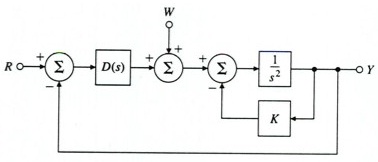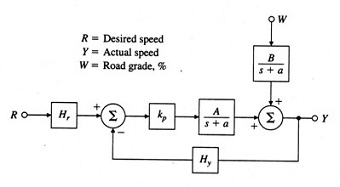Reference no: EM13844680
Problem 1:
Consider the system shown in the figure below, which represents control of the angle of a pendulum that has no damping.

(a) What conditions must D(s) satisfy so that the system can track a ramp reference input with constant steady--state errors?
(b) For a transfer function D(s) that stabilizes the system and satisfies the condition in part (a), find the class of disturbance w (t) that the system can reject with zero steady--state error.
Problem 2:
Consider the system shown in the figure with PI control.

(a) Determine the transfer function from R to Y.
(b) Determine the transfer function from W to Y.
(c) Use Routh's criteria to find the range of (kp, kI) for which the system is stable.
(d) What is the system type and error constant with respect to reference tracking?
(e) What is the system type and error constant with respect to disturbance rejection?
Problem 3:
Consider the automobile speed control system depicted in the figure.

(a) Find the transfer functions from W(s) and from R(s) to Y(s).
(b) Assume that the desired speed is a constant reference r, so that R(s) = ro/s. Assume that the road is level, so w(t) = 0. Compute values of the gains K, Hr, and Hy to guarantee that:
lim y(t ) = ro
t→∞
(c) Repeat part (b) assuming that a constant grade disturbance W(s) = wo/s is present in addition to the reference input. In particular, find the variation in speed owing to the grade change for both the open--loop ( Hy = 0 ) and feedback ( Hy ¹ 0 )
cases. Using your results to explain: (1) why feedback control is necessary and (2) how the kp should be chosen to reduce steady--state errors.
(d) Assume that w(t) = 0 and that the gain A undergoes the perturbation A + dA. Determine the error in speed owing to the gain change for both the open--loop and feedback cases. How should the gains be chosen in these cases to reduce the effects of dA?
|
Explain the greatness of theodore roosevelt
: Explain the greatness of Theodore Roosevelt make sure to include the building of the Panama Canal, winning the Nobel Peace Prize, The Three C's
|
|
Occurring simultaneously in organization
: If multiple changes were occurring simultaneously in an organization, would it make sense to merge them into one large change initiative? Why or why not?
|
|
Difference between what a consumer is willing to pay
: difference between what a consumer is willing to pay for a good or service
|
|
Green mountain coffee roasters and keurig coffee
: What strategy has GMCR/Keurig used to fuel growth? What implications does GMCR/Keurig’s corporate strategy have for its approach to innovation, and how should this strategy be managed? Why didn’t the Keurig product development engineers think of this..
|
|
Control of the angle of a pendulum
: Consider the system shown in the figure below, which represents control of the angle of a pendulum that has no damping.
|
|
What is the annual cost of ordering and holding inventories
: Race One Motors is an Indonesian car manufacturer. At its largest manufacturing facility, in Jakarta, the company produces subcomponents at a rate of 285 per day, and it uses these subcomponents at a rate of 12,500 per year (of 250 working days). Wha..
|
|
What control procedures could petty corporation have
: What control procedures could petty corporation have employed to prevent this unauthorized use of cash? classify each control procedure in accordance with the SAS 78/COSO framework.
|
|
Draw cause-and-effect diagram using branches of machines
: Draw a cause-and-effect diagram using the branches of machines, manpower, methods, environment, measurement, and materials of a call center experiencing poor customer service.
|
|
Explain the role of culture in how institutions are shaped
: Explain the role of culture in how these institutions are shaped
|